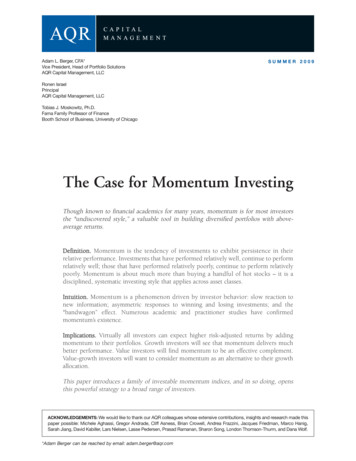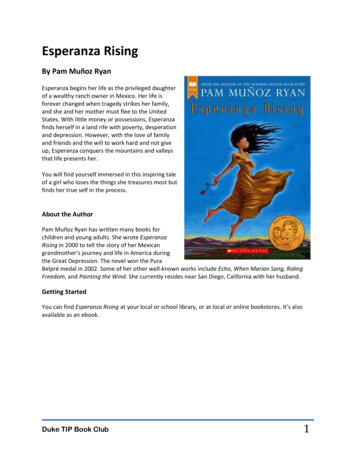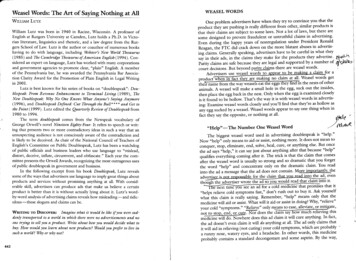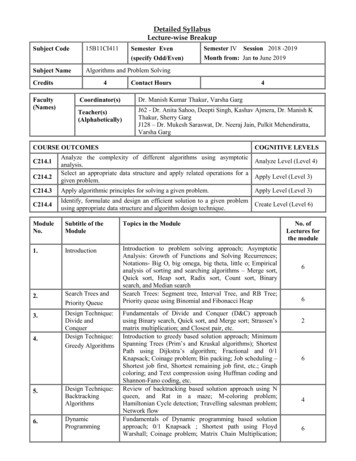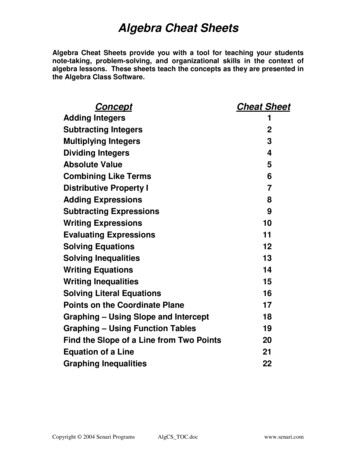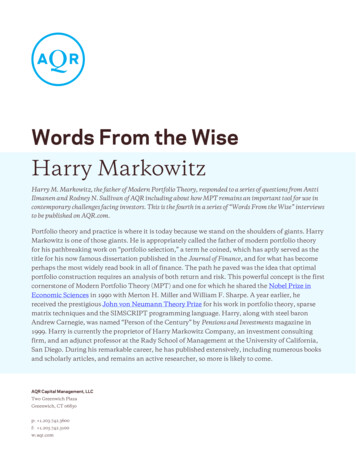
Transcription
Words From the WiseHarry MarkowitzHarry M. Markowitz, the father of Modern Portfolio Theory, responded to a series of questions from AnttiIlmanen and Rodney N. Sullivan of AQR including about how MPT remains an important tool for use incontemporary challenges facing investors. This is the fourth in a series of “Words From the Wise” interviewsto be published on AQR.com.Portfolio theory and practice is where it is today because we stand on the shoulders of giants. HarryMarkowitz is one of those giants. He is appropriately called the father of modern portfolio theoryfor his pathbreaking work on “portfolio selection,” a term he coined, which has aptly served as thetitle for his now famous dissertation published in the Journal of Finance, and for what has becomeperhaps the most widely read book in all of finance. The path he paved was the idea that optimalportfolio construction requires an analysis of both return and risk. This powerful concept is the firstcornerstone of Modern Portfolio Theory (MPT) and one for which he shared the Nobel Prize inEconomic Sciences in 1990 with Merton H. Miller and William F. Sharpe. A year earlier, hereceived the prestigious John von Neumann Theory Prize for his work in portfolio theory, sparsematrix techniques and the SIMSCRIPT programming language. Harry, along with steel baronAndrew Carnegie, was named “Person of the Century” by Pensions and Investments magazine in1999. Harry is currently the proprietor of Harry Markowitz Company, an investment consultingfirm, and an adjunct professor at the Rady School of Management at the University of California,San Diego. During his remarkable career, he has published extensively, including numerous booksand scholarly articles, and remains an active researcher, so more is likely to come.AQR Capital Management, LLCTwo Greenwich PlazaGreenwich, CT 06830p: 1.203.742.3600f: 1.203.742.3100w: aqr.com
Executive SummarySome 65 years ago, Harry Markowitz first envisioned and then formalized a solution to portfolioselection that became the cornerstone of Modern Portfolio Theory, widely referred to simply asMPT. We begin with a discussion about why his mean-variance analysis (MVA) remains so centralto MPT — and, indeed, to finance — and why it has stood the test of time. We gain from Harry’sdeep perspective and lessons learned to understand why the simple, but not simplistic, MVA is souseful to practitioners and how portfolio variance, a key input to MVA, stacks up to alternativerisk measures. Harry also addresses the “Great Confusion,” a term he gives to the recent criticismsof MVA following the global financial crisis. He describes how these criticisms are not onlyunfounded, but that his theory of portfolio selection and diversification is as relevant to investorstoday as ever before. He explains, for instance, that if investors are leverage averse the marketportfolio may not be a mean-variance efficient portfolio and, furthermore, the relationshipbetween expected returns and beta may not be positive linear as posited by CAPM theory.A perennial intellectual, Harry discusses how he has pursued academic interests since gradeschool, and the ideas and people that influenced him both intellectually and professionally.We learn how he came to study financial economics and the “eureka moment” that led to hisenvisioning the timeless solution to the portfolio-selection problem. Harry’s forward thinkingdoesn’t end with portfolio theory; we also learn about his early and meaningful contribution tothe development of advanced simulation software.Some 65 years since his seminal paper on portfolio selection, Harry Markowitz is still going strong.We discuss his current focus and plans for future research, including a comprehensive fourvolume book on risk-return analysis and the theory of rational investing, an effort currentlywell underway. Finally, we hear about Harry’s heroes, accomplishments and his biggest regret.Words From the Wise: Harry Markowitz 1
From Portfolio Theory to Practice1THE THEORY OF PORTFOLIO SELECTIONAQR: Your pioneering work on the theory of portfolio selection is a cornerstone of finance theory andpractice. Can you discuss why mean-variance analysis is so central to finance?Markowitz: I’m not sure why mean-variance analysis has become and remains “so central to finance.”Perhaps it is a combination of two reasons: the first is that it is really a minimalist approach to the problem ofportfolio selection (with the emphasis on “portfolio” as distinguished from “security” analysis). And thesecond reason perhaps is that it is so flexible.Concerning my first point — that mean-variance analysis (or MVA for short) is minimalist — surely onewants to avoid portfolio risk while seeking portfolio return. Avoiding portfolio risk must involve some notionof covariance. The formula for portfolio variance — in terms of the variances and covariances of securities —makes no assumption about the form of the probability distribution. Unfortunately, many people areconfused about this. In my new book, Markowitz and Blay (2014), I refer to this as “the Great Confusion,”namely the confusion between the necessary and sufficient conditions for the applicability of MVA inpractice. Normal (Gaussian) return distributions are a sufficient condition for MVA to hold true, but are notnecessary. However, the existence of the moments involved (the variances and covariances) is both necessaryand sufficient for the formula to hold. My justification for the use of mean and variance — as presented in2Part IV of my 1959 book — was not about Gaussian return distributions, but was about the efficacy of meanvariance approximations to expected utility. Chapter 2 of Markowitz and Blay (2014) surveys the extensive —and generally favorable — research on mean-variance approximations to expected utility.I have strayed from my point: The point is that MVA asks only for estimates of means, variances, andcovariances (or a factor model in lieu of covariances). Some say “Oh, but with MVA you are implicitlyassuming the normality of the return distribution.” But that’s just not true.As to the second point, the flexibility of MVA, Markowitz (1959) presents the “critical line algorithm” fortracing out an MVA efficient frontier subject to any system of linear equality or weak inequality constraints[that is, or , not strict the inequality of or ]. This is used in practice to put upper and lower bounds onthe securities (or asset classes) permitted in the portfolio, on the totalamounts invested in sectors, on portfolio turnover, etc. This approachgives the investor flexibility, for instance to impose legal or policyconstraints (like no borrowing or limited borrowing) on the choice ofportfolio; limit turnover in what Markowitz and van Dijk (2003) call a“Some say, ‘Oh,“Single-Period Mean-Variance Analysis in a Changing World”; take intobut with MVA you areaccount portfolio objectives other than risk and return; and forceimplicitly assuming theadditional diversification over and above minimizing estimated risk fornormality of the returngiven estimated return (e.g., don’t invest “too much” in emergingdistribution.’But that’smarkets, or other “risky sounding stuff,” because even if it were the rightjust not true.”answer in the long run for some young investor, it is a highly volatileasset class; if it took a fall right off the bat, the client might think this is adumb asset class; “I must have a dumb advisor,” etc.).1We thank David Kabiller and Dan Villalon for useful comments and suggestions, and Jennifer Buck and Mark Stein for their excellent copyediting andproduction support.2This is in reference to Markowitz’s landmark book, Portfolio Selection: Efficient Diversification of Investments (1959).Words From the Wise: Harry Markowitz 2
AQR: Can approximations based on variance alternatives such as VaR, CVaR, and semi-standard deviation,all of which focus on downside risk, improve on approximations based on variance?Markowitz: Chapter 4 of Markowitz and Blay (2014) evaluates the efficacy of various risk-return measures inapproximating expected log (a.k.a. the Bernoulli utility function). The risk criteria we considered werevariance, semi-variance, MAD (mean absolute deviation), VaR (value at risk) and cVaR (conditional value atrisk). The asset classes and databases used in our evaluation were:(1) Commonly used asset classes, such as large cap and small cap stocks, EAFE, emerging market andselected fixed income asset classes; and(2) The Dimson, Marsh and Staunton database of real-returns of 16 countries during the 20th Century, 1900-2000.We found that mean-variance was best in approximating expected utility versus proposed alternativemeasures of risk. We concluded that investors are well served by mean-variance.AQR: Following the recent financial crisis, portfolio theory, and mean-variance analysis in particular, hascome under fire for what some say as having failed investors. Your thoughts?Markowitz: Mean-variance analysis is an apparatus that can be usedor misused. It’s up to the user to choose the universe of securities orasset classes, estimate means, variances and covariances, andchoose constraints. During crises, those who leveraged exoticinstruments based on optimistic estimates got into trouble. Thosewho stuck to diversified portfolios of standard asset classes andrebalanced as the market fell — to their benefit and to the detrimentof those who were forced to sell (or just decided to do so) near thebottom — did well, over time.“We concluded thatinvestors are well servedby mean-variance.”AQR: Can you discuss how your views on the efficient portfolio have changed over the years? For instance, inyour article “Market Efficiency: A Theoretical Distinction and So What?” (FAJ 2005) you find that making asingle change to the underlying CAPM assumptions leads to some dramatic implications for the efficiency ofthe market portfolio.Markowitz: Recall that CAPM is not my hypothesis. Rather it was Bill Sharpe’s, among others. The articleyou cite shows that if you keep all the assumptions of CAPM, except the assumption that all investors canborrow all they want at the risk-free rate (or can short and use the proceeds to buy long positions, withoutlimit) then it no longer follows that:(a) the market portfolio is a mean-variance efficient portfolio; and(b) there is a positive linear relationship between expected returns and the betas one gets by regressingagainst the market portfolio.Thus, if such a linear relationship does not exist (as some find, for instance that stocks with higher betas donot earn higher returns), the obvious explanation for this is that not all investors can borrow all they want atthe risk-free rate.AQR: Yes, some intriguing investment opportunities may emanate from leverage aversion.33See, for instance, Asness, Frazzini, Pedersen (2012).Words From the Wise: Harry Markowitz 3
APPLYING PORTFOLIO SELECTION THEORYAQR: You mentioned the importance of portfolio diversification to MVA. What is the role of alternative assetclasses (e.g., commodities, real estate, and private equity) in a diversified portfolio? Likewise, what is the roleof alternative strategies (e.g., long/short, equity-market-neutral and arbitrage) in a diversified portfolio?Markowitz: I will answer that question at two levels, one from a portfolio theory point of view, and the otherfrom casual observation. From a portfolio theory viewpoint, as I said before, the user of MVA gets to chooseits universe, make its estimates and set its constraints. The optimizer finds efficient portfolios based on theseestimates subject to these constraints. The analysis is blind as to whether the members of this universe arestandard investments or alternative investments. However, one must be careful that the inputs reflect reality;for instance it is well known that illiquid investments are often priced with a lag, creating challenges inproperly measuring the covariances with their more liquid counterparts.As to whether alternative investments are a good thing, here I defer to the teachings of David Swenson, ChiefInvestment Officer of the Yale University endowment. He writes that there is a large industry of intelligent,highly motivated people cranking out products, all of which add to their creator’s bottom lines but notnecessarily to their investors’. The challenge is to be able to evaluate the efficacy of such products.AQR: What constitutes alpha, and what is your view on smart beta?Markowitz: In general, MVA requires means, variances and covariances as inputs, and has portfolio meanand variance as outputs. A model of covariance (such as a one-factor model or a multi-factor model) canserve instead of individual covariance estimates. In particular, if you assume the Sharpe (1963) one-factormodel of covariance, the portfolio performance breaks into a portfolio alpha, plus a portfolio beta and anidiosyncratic risk. Alternatively, if you assume Sharpe’s (1964) CAPM, then expected return is proportional tobeta, and any difference between the forecast expected return and that which CAPM predicts is referred to as“alpha.” If you assume neither Sharpe (1963) nor Sharpe (1964), then alpha and beta are not defined.As to “smart beta,” it’s like “All Natural” food at the grocery store: many different things label themselves“smart beta.” Not all are equally good (or bad). Again, investors need to evaluate the efficacy of such productsbased on their merits.AQR: Your thoughts on investors’ ability to be successful in tacticallytiming the market over the long-term?Markowitz: One sure-fire way to market-time is to rebalance the portfolio.This has proven a useful approach over time. Alternatively, one might tiltthe portfolio a bit this way or a bit that way when P/E ratios are very highor very low in accordance with the Shiller P/E approach. This approachmay safely add a few basis points. Beyond these two approaches, I see noevidence of anyone’s ability to market time.AQR: I understand your latest book is only the beginning of a series ofbooks on investing, what is on your research agenda looking ahead?“ many different thingslabel themselves “smartbeta.” Not all are equallygood (or bad). Again,investors need toevaluate the efficacyof such products basedon their merits.”Markowitz: I am currently writing a four-volume book titled Risk-ReturnAnalysis: The Theory and Practice of Rational Investing, Volume I was justrecently published (McGrawHill Professional, 2013) and concerns single-period analysis assuming knownodds. Volume II, which I have now completed writing and will be available soon, expands on the first volumeby exploring decision making over many periods, still assuming known odds. I am now hard at work onVolume III, which concerns analysis under uncertainty — when odds are not known. Finally, Volume IV willcover assorted investment topics not covered in the first three volumes. When completed, the four volumeswill combine for a comprehensive treatment of investment theory and practice.Words From the Wise: Harry Markowitz 4
AQR: I have read that you select your own portfolio allocation based largely on regret considerations insteadof MVA. Can you discuss?Markowitz: Circa 1952, I was offered the choice of a stock/bond portfolio in the form of CREF versus TIAA.I chose a 50-50 mix. My reasoning was that if the stock market rose a great deal, I would regret it if I wascompletely out of it. Conversely, if stocks fell a great deal and I had nothing in bonds I would also haveregrets. So, my 50-50 split minimized maximum regret. The conclusion that some commentators draw fromthis story is that even Markowitz, creator of MPT, does not use MPT in his own choice of portfolio.The 50-50 split was my choice at age 25 in 1952. But it would not be my recommendation now for a 25-yearold. My recommendation now would be much more heavily weighted toward equities, perhaps as much as100% equities, depending on the individual’s willingness to put up with fluctuations in portfolio value in theshort run. Since 1952 a vast MPT infrastructure has been built. In 1952, there was my “Portfolio Selection”article, but no optimizers had been programmed, and no return-series data (such as that of Ibbotson (2014)or Dimson, Marsh and Staunton (2002)) were readily available. Nor had there been decades of discussionbuilding on how best to use the MPT apparatus. All of this discussion over the years I have enjoyedenormously with the many friends and colleagues that I thank in the Acknowledgements section of Volume Iof Markowitz and Blay (2014).DISCOVERING PORTFOLIO SELECTIONAQR: Can you discuss how you came into the investment industry?Markowitz: To answer your question I have to go back to my high school days, in the early 1940s. Growingup, I enjoyed baseball and tag football in the nearby empty lot or the park a few blocks away, and playing theviolin in the high school orchestra. I also enjoyed reading. At first, my reading material consisted of comicbooks and adventure magazines, such as “The Shadow,” in addition, of course, to my school assignments. Inlate grammar school and throughout high school I came to enjoy reading popular accounts of physics andastronomy. In high school I also began to read original works of serious philosophers. I was particularlystruck by David Hume’s argument (Hume and Beauchamp (2000)) that, though we release a ball a thousandtimes and each time it falls downward, we have no proof-positive that it will do so the thousand and firsttime. I also read The Origin of Species (1866) and found quite inspiring Darwin’s marshalling of facts andcareful consideration of possible objections to his theory of evolution.From high school, I entered the University of Chicago, enrolling in its twoyear Bachelor’s program, which emphasized the reading of originalmaterials where possible. I found everything in the program interesting, butI was especially interested in the philosophers we read in a course called OII(Observation, Interpretation and Integration). After completing theBachelor program, I decided on economics as my upper-division program.I found both micro- and macroeconomics interesting, but eventually it wasthe Economics of Uncertainty that really sparked my interest — inparticular, the expected-utility theory proposed by John von Neumann andOskar Morgenstern and also Jacob Marschak. I was further intrigued by theFriedman-Savage utility function postulated by Milton Friedman andLeonard J. Savage, and Savage’s defense of personal probability.(See Friedman and Savage 1948; L. J. Savage 1972.)“When time camefor me to choose mydissertation topic, achance conversationled to the idea for.applying mathematicalmethods to thestock market.”At Chicago, I had the good fortune to have Friedman, Marschak and Savage, among other great teachers.A crucial aspect of my education was Koopmans’ course on Activity Analysis, which provided a definition ofefficiency and the analysis of efficient sets.Words From the Wise: Harry Markowitz 5
While at Chicago, I was invited to join the Cowles Commission for Research in Economics as a studentmember. Since the Cowles Commission has had a significant influence on economic and econometricthought and has produced numerous Nobel Laureates, some might imagine it to be some gigantic researchcenter. In fact, it was a small but exciting group, then under the leadership of its director, Tjalling Koopmans,and its former director, Professor Marschak. When time came for me to choose my dissertation topic, achance conversation led to the idea for the possibility of applying mathematical methods to the stock market.I asked Professor Marschak what he thought about this idea. He found it interesting and explained to me thatAlfred Cowles himself had been interested in such applications. He then sent me to Professor MarshallKetchum, in the business school, who offered me a reading list which was an excellent survey of the literatureof financial theory and practice of the day.AQR: What led to your “discovery” of MVA?Markowitz: The key concept behind what eventually came to form the core of my work on portfolio theorycame to me one afternoon in the library while reading John Burr Williams’ Theory of Investment Value (1938).Williams proposed that the value of a stock today should equal the present value of its future dividends.However, future dividends are uncertain, so I interpreted Williams’ proposal to be to value a stock by itsexpected future dividends. At this point my thought process went as follows: if the investor was onlyinterested in the expected values of securities, then he or she would only be interested in the expected valueof their portfolio. In turn, to maximize the expected value of a portfolio, one would need to invest only in asingle security — that one which provided the greatest expected return.But, I knew that investors did not behave this way in reality. Investors,as they should, think about their portfolio as a whole and diversifybecause they are concerned with risk as well as return. Variance (or,equivalently,) standard deviation, came to mind as the most commonlyused measure of risk. The fact that portfolio variance depended onsecurity covariances added to the plausibility of using variance to proxyfor risk. (At the time, the financial literature spoke of risk but did nottake into account covariances.) As there were two portfolio evaluationcriteria — risk and return — it was natural (for me as a budding youngeconomist) to assume that investors would choose their portfolio fromthe set of Pareto-optimal combinations of risk and return.“As there were twoportfolio evaluationcriteria — risk and return— it was natural thatinvestors would choosetheir portfolio from theset of Pareto-optimalcombinations of riskand return.”AQR: This is the backdrop that led to your now famous dissertation“Portfolio Selection” published in Journal of Finance in 1952?Markowitz: Yes, exactly. All of these insights came about without my having any knowledge of theinvestment industry at the time. Except, I did know that mutual funds diversified, as I learned from readingWiesenberger’s 1958 book Investment Companies and Their Securities, which was the most comprehensiveguide to mutual funds available at that time. It was an exciting time to be studying financial economics.AQR: You were awarded the Nobel Prize in 1990 along with Bill Sharpe and Merton Miller — some prettyspectacular company. How has receiving the Nobel changed your life?Markowitz: I get requests for autographs from all over the world from people who have no idea as to what MPT is.AQR: Our sincere thanks Harry, for sharing your insights gained over many years of intense study. We aregrateful for your many contributions and enthusiastically look forward to seeing the completion of your fourvolume book series on risk-return analysis and the theory of rational investing.Words From the Wise: Harry Markowitz 6
HEROES, ACCOMPLISHMENTS AND REGRETSAQR: You have been appropriately called the father of modern portfolio theory. The investment profession has learnedso much from you; who are your mentors and heroes?Markowitz: My heroes are John von Neumann, Leonard J. Savage and George Dantzig. I had Savage as a teacher atthe University of Chicago. As I mentioned earlier, I learned much from him. I was also very fortunate to have Dantzig asa friend and mentor at the RAND Corporation.AQR: What achievements are you personally most proud of?Markowitz: That is a hard one, but I have to go with my 1959 book Portfolio Selection: Efficient Diversification ofInvestments, with SIMSCRIPT II, the simulation programming language, being a close second.AQR: On the flip side, any regrets — something you missed or got wrong?Markowitz: As I explain on page 7 of my book Selected Works, my greatest regret is not having the opportunity tofinish SIMSCRIPT II as planned, with database entities, attributes, sets and events as well as supporting simulationmodels for these.AQR: Your book, Portfolio Selection, we all know and love, but can you expand on why SIMSCRIPT is so important to you?Markowitz: The EAS-E (entity, attribute, set and event) view of dynamic systems description was first presented inSIMSCRIPT: A Simulation Programming Language by Markowitz, Hausner and Karr (1962). The most obviousdifference between the original SIMSCRIPT and the “standard” programming languages of that day was the centralrole that the EAS-E worldview played in SIMSCRIPT. But more fundamental than that was a difference in theobjectives of SIMSCRIPT as compared to those of conventional programming languages. The latter sought to tell thecomputer what actions it (the computer) should take. For example, FORTRAN required the programmer to think andcode in terms of variables and arrays, leaving a program “compiler” to figure out where and how these variables andarrays would be stored and accessed. The original SIMSCRIPT was a preprocessor into FORTRAN II, and thereforeused precisely the same variables and arrays as did FORTRAN II. But SIMSCRIPT programmers were not supposed tothink in terms of variables and arrays. Rather, they were supposed to think in terms of the world as they wanted toportray it: what types of entities would populate their simulations; what attributes and “set” relationships wouldcharacterize the “status” of these entities at any instant of time; what kinds of events would alter status; and whatcaused these events to occur. It was up to the SIMSCRIPT preprocessor to figure how these modelling specificationswould be represented in variables, arrays and FORTRAN II routines.Thus the principal objective of the original SIMSCRIPT — and each of the SIMSCRIPTs that followed — was not to bea programming language, but essentially to be an “executable modeling language.” It sought to allow the modeler toconveniently specify the world to be simulated, the analyses to be performed on this world, and how the results ofthese analyses were to be displayed: hence, for example, commands in all SIMSCRIPTs to process entities and sets;the WYSIWYG (What You See Is What You Get) report generation facilities of all SIMSCRIPTs, and SIMSCRIPTs II.5and III’s 2D and 3D graphical facilities.The SIMSCRIPTs have been used commercially for decades to build simulators for a great variety of real-worlddynamic systems used by Fortune 500 companies and other prominent organizations. The SIMSCRIPT II Joint StrikeFighter simulator is used extensively by NATO and governments in over 20 countries for important planning and4decision analyses.4See Markowitz and Blay (2104).Words From the Wise: Harry Markowitz 7
HEROES, ACCOMPLISHMENTS AND REGRETSAs described in Markowitz (1979), SIMSCRIPT II was to be implemented — and documented — in seven levels.Specifically, Level 1 is a simple “teaching language;” Level 2 is a full-fledged programming language with capabilitiescomparable to those of Fortran II; Level 3 is a more advanced general purpose programming language; Level 4introduces Entities, Attributes and Sets, and commands to process them; Level 5 presents the SIMSCRIPT IIsimulation capabilities; Level 6 was to introduce database entities and sets, and Level 7 was to make available tosystems programmers the LWL (Language Writing Language) with which SIMSCRIPT II itself was built.RAND completed SIMSCRIPT II through Level 5 with me as a consultant — after Herb Karr and I left RAND to formCACI to give SIMSCRIPT courses, do simulation consulting and, later, rebuild the original SIMSCRIPT as CACI’sSIMSCRIPT I.5.On March 15 (the Ides of March), 1968 I left CACI at the request of Herb Karr and James Berkson who togetherowned a majority of CACI stock, thus settling the question of how CACI would make major decisions when its foundersdisagreed. CACI tried to complete my plans for Level 6 without me, but could not.I finally got my chance to build and demonstrate Level 6 when I worked at IBM Research. IBM EAS-E is the RAND(public domain) SIMSCRIPT II with Level 5 removed and with the Markowitz, Malhotra and Pazel (1983) implementation ofLevel 6 added. The IBM EAS-E implementation of Level 6 was completed about the time that IBM finished converting fromIMS to System R — including software development, manual writing and staff training. IBM management was not about tobe persuaded to convert again in the then foreseeable future.The objective of SIMSCRIPT II Level 6 was to facilitate the building of database supported “decision support systems”such as the systems now programmed with much greater difficulty using relational databases. It is my observation,based on decades of simulator programming by myself and others, that SIMSCRIPT II through Level 5 reducessimulator programming time many-fold. A priori, I would expect the same for the building of decision support systemsusing SIMSCRIPT II through Level 6. Limited real-life experience with IBM EAS-E confirmed this. See Markowitz andBlay (2014) Chapter 12 for details.If I am right — that SIMSCRIPT II Level 6 can greatly simplify the programming of the Enterprise Systems that runmajor business — then SIMSCRIPT II’s impact on the world will far exceed even that of MPT. I failed to persuade topIBM management of this circa 1983. I note as a historical fact that in the past when I held a view strongly, and theworld thought otherwise, eventually most of the world decided I had been right and it had been wrong.Words From the Wise: Harry Markowitz 8
ReferencesAsness, Clifford, Andrea Frazzini and Lasse Pedersen, 2012, “Leverage Aversion and Risk Parity,”Financial Analysts Journal. Vol 68, No. 1 (January/February 2012). pp. 47-59.Darwin, Charles, 1866, On the Origin of Species by Means of Natural Selection: or the Preservation ofFavoured Races in the Struggle for Life, John Murray, Albemarle Street.Dimson, Elroy, Paul Marsh and Mike Staunton, 2002, Triumph of the Optimist, PrincetonUniversity Press, Princeton, N.J.Friedman, Mi
(1) Commonly used asset classes, such as large cap and small cap stocks, EAFE, emerging market and selected fixed income asset classes; and (2) The Dimson, Marsh and Staunton database of real-returns of 16 countries during the 20th Century, 1900-2000. We found that mean-variance was best in a
